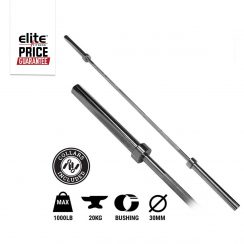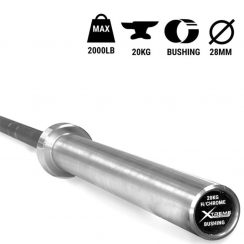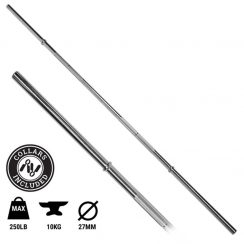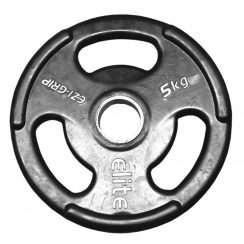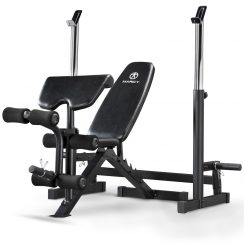Working out with weights used to conjure up images of burly, muscly blokes and ripped women pumping heavy iron a million times their body weight. And sunbeds. Lots of sunbeds.
But these days, strength training attracts people of all ages and body types, who understand the proven benefits of weight training to build strength, increase bone density, maintain fitness levels, improve mental health and contribute to general wellbeing. And thankfully, we all know how to use fake tan instead of sunbeds.
At Elite, we’ve got over 30 years experience in the biz, and it’s fair to say that in the last decade or so, more and more customers are asking how to get fitter, stronger and healthier using dumbbells and barbells in their workouts. Why? Because it works and importantly – it feels great.
What weights should I buy?
There are so many products on the market today which is why we’ve put this buyer’s guide together, to help you to navigate through the confusion and highlight the top features and best brands to consider.
Like any fitness equipment, the first step is defining what you want it for. Do you want to train for weight lifting, or even bodybuilding or powerlifting? Train for Strongman or CrossFit? Or have some free weights on hand for general use to help with basic strength training as a beginner?
Naturally, all of these types of exercises require different types of tools.
‘Olympic’ versus ‘Standard’ dumbbells & plates
When it comes to barbells and plates, there are two types of industry sizes you’ll see in homes and gyms alike, “Standard” and “Olympic”. Which one suits you best will be determined by what you want to train for, and perhaps also what you’re already used to.
Let’s start with barbells, and go into plates after that.
Olympic size barbells
Olympic bars are considered slightly higher quality in terms of materials and are popular with more serious lifters as they’re made to sustain a great amount of weight. Hence the bar is thicker, to load on big, grunty plates.
At seven feet long (sometimes 6 ft to cater to shorter lifters), the Olympic bar is 28 millimeters in diameter, and the sleeves that the weights slide onto at both ends are 50 millimeters in diameter.
Numerous styles of Olympic barbells are available that are suited for various purposes, while still maintaining these dimensions.
A big difference between the sizes is that the bar sleeves (where the weight plates are held), rotate as you lift on Olympic bars.
Olympic bars are made to be used with other training equipment, like benches and power racks. Standard bars are often made with smaller dimensions so they don’t always fit. So if you’ve already got a rack and are just replacing the bar, it will pay to check the length if going ‘standard’.
The weight of the bar itself can vary from 15kg to 22kg, but usually for everyday weightlifting training (overhead lifts, deadlifts, squats etc), the most popular is 20kg.
You’ll notice that Olympic bars are weight rated, which is determined by maximum load weight the bar can handle; 300lb, 700lb, 1000lb and 1500lb ratings are standard in the market today. It’s important to note these ratings are not ‘dropped weight’, it’s a static weight for weight lifting purposes.
Best option: Elite 1000lb 7FT Olympic Training Bar
What are Olympic bars made of?
The quality of the steel used in the bar will determine how well a bar keeps its shape.
If it’s a good bar, the materials will be of highly-elevated drawn high tensile steel, which sounds rather complicated but translates to ‘plain tough’! It’s flexible as well as durable.
The bar sleeves, where the weight plates are held, need to be machine finished for smooth sleeve rotation provided by high-quality bushes or bearings when loaded with plates.
Bushes and bearings are also very important on a bar that’s going to be dropped heavily. Brass bushings and German or USA made bearings are a good sign of quality.
One of the best ways to rate a bar is through ‘tensile rating’. Most manufacturers don’t provide this, just a static weight rating of say 700lb. But if the manufacturer does provide a tensile rating, chances are it’s a very well made bar. Look for a tensile rating of 190,000 psi or above to show real quality.
Black oxide coated bars are now really popular as well.
Weight lifting vs powerlifting
Olympic weightlifting (i.e. the competitive sport) focuses on performing two ballistic lifts over the head with two controlled techniques, known as the ‘clean and jerk’, and the ‘snatch’.
Powerlifting, on the other hand, focuses more on completing three, controlled, heavy lifts known as the squat, bench press, and deadlift.
Each respective sport has exacting requirements for barbells and weight plates when it comes to competition, which you can read more about here.
A bar designed for the official sport of Olympic weightlifting is made of flexible steel, to provide a ‘whipping effect’ during lifts (slight bend). Yet other Olympic bars are made without this effect, for everyday bench pressing and squatting – for general training and bodybuilding, which you will likely see at the gym.
An Olympic bar used in competitive and day-to-day powerlifting is more stiff, providing stability with maximum weights. A CrossFit bar is similar, and both are made to sustain being dropped regularly.
Olympic bars for Powerlifting & CrossFit
Powerlifters and CrossFit trainees can have similar requirements in terms of needing straight bars that will be dropped frequently.
The main difference to traditional weightlifting bars, is that the hardened steel has been manufactured to increase strength, so expect to pay a tad more than a standard weightlifting bar.
Best options: 20kg Xtreme Mens Bar
Standard bars
Despite the name, “standard” barbells have little in common with one another in terms of their dimensions.
In contrast with the 50 mm diameter (2.0 in) rotating sleeves of Olympic bars, the ends of standard bars don’t rotate, and they mount plates with a centre hole around 25-27 mm (0.98 in).
The better made a standard bar the thicker it is.
Standard bars generally come in 5ft, 6ft and 7ft lengths to accommodate for different training environments and heights. They will weigh 8kg, 9kg and 10kg respectively from a good manufacturer.
If you’re a beginner you should probably give a Standard bar a go, they’re cheaper and lighter in weight.
A good quality bar will be thick, at 27 mm and lathed from one piece of steel including the collars, and will have a flake resistant chrome finish.
There are of course different qualities in the market. Look out for with the cheapest and poorest quality bars that generally tend to be 25mm in width and usually having pressed on or welded on collars to hold the plates in place. With moisture from sweat and tears perspiration, these collars can easily corrode.
Best option: Elite 7ft Standard Weight Bar
———
Weight Plates
There are a number of important things to look for when searching for new weight plates.
A plate should have contoured hand grips so they’re easily picked up and gripped (ideally with holes for your fingers), especially if you want to use them like free weights as many workout programmes will suggest.
Ask the supplier if they can guarantee that the plates are made without putties or fillers which are a common practice in cheap iron cast manufacturing.
Tip: if the plate has small air bubble imperfections when you look up close, this could be a sign of bad quality. It could affect the overall weight of the plate and quality may be compromised.
The supplier should be able to guarantee a weight inaccuracy of no more than + or – 5%, (cheap manufacturing can be + or – 10%).
Also, at Elite, we like to promote forward-thinking companies that adhere to environmentally friendly practices. Suppliers should be able to tell you this kind of detail as well.
Cast Iron Olympic Weight plates
Cast iron Olympic plates usually come in 1.25 kg, 2.5kg, 5kg, 10kg,15kg, 20 kg and 25kg weight options.
Best option: Elite Ezi-Grip Olympic Weight Plates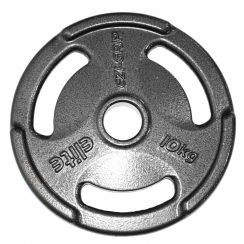
Cast Iron Standard Weight Plate
The most cost-effective type of plate, the cast iron ‘standard’ plate, will only fit on standard bars (the centre hole will be too small for an Olympic bar), and usually comes in 1.25 kg, 2.5kg, 5kg, 10kg, 15kg, 20kg and 25kg weight.
These plates will vary in thickness and diameter (depending on weight) often with a 27mm diameter hole.
Best option: Elite Ezi-Grip Standard Weight Plates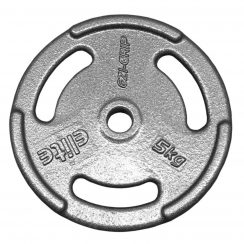
Vinyl or Plastic Standard Plates
These types of plates are at the cheapest end of the market and tend to be filled with iron or sand. They are thicker, which restricts the amount that you can fit on a bar, and can easily crack or split if dropped.
We only recommend these plates to beginners and occasional trainers, and always suggest that people are careful not to drop them too often.
These plates come in 1kg, 1.25kg, 2.5kg, 5kg and 10kg increments with a 25mm diameter hole.
Best option: Elite Vinyl Weight Plates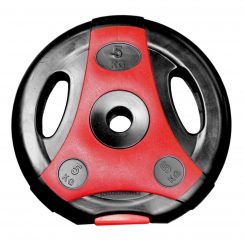
Rubber Coated Olympic Plates
Rubber coated Olympic plates are essentially the same high quality as the cast iron Olympic plates, but they have a softer PVC surface which is easy to handle and reduces chipping if dropped on hard surfaces (ideal for the garage).
They are popular in all strength training circles – we sell a lot of these.
The good brands are made to the same accuracy standards (including no fillers or putties) as Olympic cast iron plates. They should ideally have a steel insert for the 50mm centre hole (to fit your Olympic size bar).
If you think you’re going to be dropping plates from a great height though, onto a hard surface, you may like to consider ‘bumper plates’ (up next).
Best option: Elite Ezi-Grip Olympic Rubber Weight Plates
————–
Bumper Plates
Bumper plates look like ‘rubber plates’ (with cast iron insides), but in fact are made entirely of materials similar to rubber, all the way through.
They are used for training regimes where you’re likely to drop your plates a lot (purposefully that is), such as deadlifting, or clean and jerk movements for powerlifters, or a variety of CrossFit exercises.
They come in 2.5kg, 5kg (technique plates only), 10kg, 15kg, 20kg, and 25kg weights.
It’s essential to get the correct plate for safe training, floor protection, and the durability of the plates themselves – so we reckon you should consider these as an option.
Choosing Bumper plate can however be a minefield as there are so many standards, classifications and terms associated with each brand. Let’s try and simplify things:
- 10,000 Drop tested: This indicates that this particular plate has been tested to withstand a drop from above head height for the indicated amount onto a regulation platform with regulated weight spread.
- 100% Virgin rubber: The greater percentage of virgin rubber in a plate the stronger and more durable the plate will be.
- Urethane Bumper plates: Urethane is a very good quality (and low smell) substitute for rubber. European or USA Urethane is the highest quality.
- 70-80 SHA: SHA is an abbreviation for ‘Shore Hardness’. Shore hardness is the amount of bounce the bumper plate has when dropped. The lower the bounce the better for safety. A SHA of 70 – 95 is an accepted level. ‘Dead blow’ is a term for the lowest bounce plates if it’s indicated.
- Weight tolerance: A weight accuracy tolerance of +/- 2% or less is generally acceptable. For competition bumper plates, the weight tolerance is much lower + or – 10 grammes of the specified weight.
- IWF standard colours: The International Weightlifting Federation has certified colours, diameters and weight tolerances. So, if a plate is IWF compliant, it’s of the highest quality and can be used in competition.
- Chemically bonded steel insert: The centre steel insert is paramount to the integrity of a bumper plate. chemically bonded is the best manufacturing process.
Standard Olympic Bumper plates
At the cheaper end of the bumper plate range, these plates are ideal for general day-today weightlifting. Sure, they will have lower drop test ratings (less than 10,000) but for beginners we reckon this is OK, as long as you’re buying a decent brand. Keep in mind that cheaper options will be a mixture of rubbers and will therefore be less durable over time.
B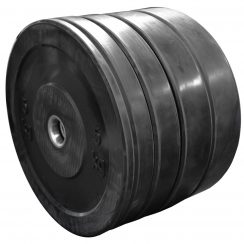 est Option: Elite Black Rubber Bumper Plate
est Option: Elite Black Rubber Bumper Plate
Coloured Bumper Plate
The IWF (International Weightlifting Federation) use colours to help them differentiate weight plates and also to display whether they are IWF compliant. So if a plate is coloured, it will imply that the quality is high.
It will also look cool on your weight rack, and is helpful when you’re in the zone and don’t want to muck around checking weight sizes – you can just grab the green plate and know it’s 10kg.
Best Option: Xtreme Elite Coloured Bumper Plate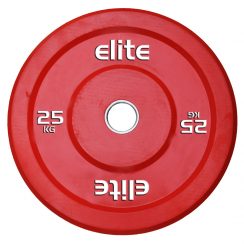
Urethane Olympic Bumper Plate
Although virgin rubber is the best option for materials, Urethane is a high-quality alternative. They are long lasting, have a high-quality steel core with very accurate weight ratings (usually+ or – 2%).
European and USA Urethane is the highest quality and as a bonus, these plates are completely odour free.
B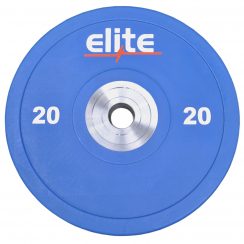 est Option: Elite Premium Olympic Urethane Bumper Plates
est Option: Elite Premium Olympic Urethane Bumper Plates
Technique Bumper Plate
These plates are for beginners who are learning their weight training or cross-training technique. It’s important to start out with light weights and nail your technique, even if you feel your core strength is good. Proper technique prevents injuries and will help you get the most out of each workout.
Technique plates are usually in 2.5kg and 5kg weights only, and are made from strong polyurethane. They’re usually a thicker plate than standard plates for durability.
Lighter plates of 2.5kg or 5kg in a standard bumper plate may bend as the lightweight restriction means that the plate is thinner, therefore less durable. So we often recommend these ones instead.
Best Option: Xtreme Elite Technique Plate 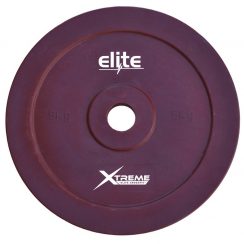
Competition Bumper Plate
For the admirable serious trainers amongst us, the competition-rated bumper plate has to have all of the highest standards available in the market today.
We’re talking the best Sha ratings (over 90 Sha is best practice), the lowest weight inaccuracy + or – 10 grammes, and have IWF colouring so they can be identified at a glance.
Competition plates will have smart design features like raised rubber flanges (which is a raised rubber surface to prevent direct metal-on-metal contact between the centre discs), and a steel insert of hardened chrome plated steel to ensure the integrity of the plate for years of training.
Best option: Xtreme Elite Competition Bumper Plate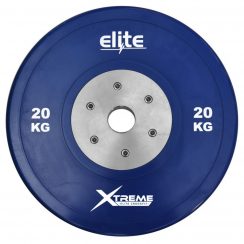
Can you put Standard plates on an Olympic barbell?
You cannot use standard weight plates on an Olympic barbell because the bar thickness will be too wide, but you can use a sleeve adapter to put Olympic plates (with larger holes) on a standard barbell.
Cleaning your barbell
Owning a barbell comes with a little maintenance in the form of cleaning and oiling up. This helps prevent the spread of bacteria (especially if there’s more than one user) and helps keep rust away.
You should do the following regularly:
- Use a dry nylon bristle brush to remove any sweat, chalk and residues on the bar.
- Wipe down the bar with a thin layer of oil and use the nylon brush to rub oil into the knurl.
The steel will absorb the oil and keep your bar healthy. - Wipe off any excess oil with a dry towel.
Fixed & Adjustable Dumbbells
A dumbbell is a small ‘free weight’ you can hold in each (or one) hand, consisting of a grip bar and two disc-shaped weights at each end, spaced just far enough apart to comfortably accommodate your hand.
Dumbbells are probably the most versatile tool in a strength trainer’s arsenal. They can be used for strength and size improvements, functional training and general fitness and the beauty of them is that they promote independent movement, making them ideal for balancing out weaknesses on the left or right side of the body.
There are a few options to consider, with fixed and adjustable weights.
Fixed Dumbells
‘Fixed’ dumbbells refer to the weight of a bar being fixed, so not adjustable (by weights being removed off each end). They come in a range of sizes usually from 1kg – 10kg, in 1kg increments. And then in 2.5 incremental jumps up to 50kg.
There are two types of fixed dumbbells, ‘rubber hex’ and ‘cast iron hex’. You guessed it, this refers to the materials they’re made and covered with – essentially soft rubber coating or harder cast iron.
Rubber hex
Rubber hex is the most the common type of fixed dumbbell. They’re hexagonally shaped so they don’t roll away, have a chrome knurled (grippy) handle and a steel weight end with a heavy rubber coating for protection. We think they’re nicer to use but they are a tad more expensive.
A good manufacturer will use high-quality rubber for durability (look for a percentage of virgin rubber), non-flaking chrome handle, and welded plates on the end of the handle inside the rubber ends, giving the rubber moulding a better more durable connection to the bar (ensuring the rubber ends don’t break off when dropped).
Best option: Elite Chrome Handle Rubber Rubber Hex Dumbbells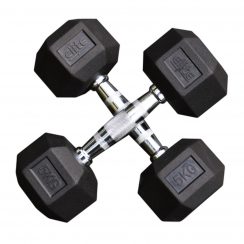
Cast Iron Hex
As mentioned this option is cheaper than rubber hex styles. If you don’t mind the harder ends, the saving may be worth it to you.
Cast iron dumbbells are usually the same shape and size as the rubber hex, but they have a very hard exterior and usually have knurling on the handle for a better grip.
Qualities can vary hugely with this type of dumbbell – so take care. We’ve seen some poorly moulded shapes with sharp edges or easily chipped outer coatings on cheap rip-offs.
Adjustable Dumbbells
The problem with fixed dumbbells is that they can take up a lot of space especially if you have a few different weight options. Adjustable dumbbells are a handy alternative as they have the ability to change out weights onto one dumbbell bar.
The initial price outlay for these type of dumbbells is comparatively high but is certainly worth it if you’re looking for a range of weights/sizes and don’t have a huge space for a rack to store them all.
Bowflex adjustable dumbbells represent the pioneering technology in the market. Please be wary of inferior, unknown brands, as there are a lot of copies of this technology on the market.
Best options: Bowflex SelecTech 560 Dumbbells 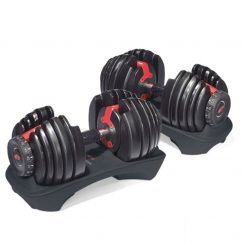
Adjustable Dumbbell Sets
A dumbbell / barbell weight set offers great value for money, giving you a variety of adjustable weight options to put on your dumbells or bar. So you can flick between using the bar, and free weights – always good practice.
They usually comprise a number of standard cast or plastic/vinyl plates, and single handlebars (spinlock).
The plates usually come in a variety of configurations: 0.5kg, 1.25kg, 2.5kg and 5 kg allowing you to choose the desired weight.
Tip: Make sure that the spinlock collars have rubber inserts to secure the plates. And also, thinner cast plate designs are recommended as there is only a limited amount of space at each end.
Best adjustable dumbbell set: Elite 52kg Ezi-Grip Adjustable Barbell & Dumbbell Set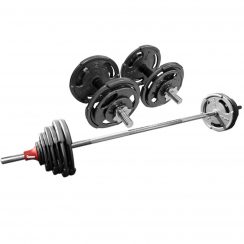
Weight Benches & Racks
Now you’re all set up with a quality barbell, accompanying plates and dumbbells, you may want to also think about a decent bench for those bench-presses, or a weight rack for support.
We’ve got a large selection – check out our range under strength training products.
Weight training accessories
Consider using medicine balls and weight bags – all equipment that can help you to change things up and shift gear, and give you a range of different exercises. It helps mix things up from the traditional weights you may have.
Many lifters who are serious about strength training will purchase lifting gloves, which will protect the skin on your palms and provide grip support, which is essential if you’re going large and you’ve got sore and sweaty hands.
Check out all of our helpful accessories available.
Weight storage racks
We’ve got some stylish storage options for plates and dumbbells that help make you feel like the serious trainer you are.
It’s a nicer way to display and store equipment, and much easier to grab what you need during a workout.
Checkout our range of weight racks and trees.
Flooring
As we’ve mentioned a few times in this post, the weights you purchase will depend on how they will be dropped, and the surface. Yes, you’ll want to be thinking about the durability of your weights – but also think about your precious floors.
Many people set up a home gym in the trusty ol’ garage, and the ground is often concrete. This is fine for a while but soon you may notice your weights deteriorating (depending on the materials). Other people may have carpet – but the surface could easily get ruined with your weights.
An easy solution is to have some durable, affordable rubber mats to hand.
Beware of cheap weight sets
Unfortunately, that cheap weight set you spotted online may be too good to be true.
We can’t stress this enough – please be wary of cheap imitation gear out there – especially brands from China. They will not be built to exacting standards of the popular (well tested) USA or European brands, materials will be inferior, and they will likely have bad guarantees.
Not only will they perform badly they could be dangerous to use.
Try before you buy with Elite Fitness
Rule of thumb for strength training is to get a feel for the various pieces of equipment, ideally with weight packed on, before you buy.
Everyone is so different with their needs, but also how their bodies move when they lift, and even how they grip bars and dumbbells. So ideally pop into a store and have a play and a chat.
Another note is that we recommend that you always buy with a weight limit in mind that exceeds your current limit – by loads! This will accommodate for progression in the future (that will totally come, you can be sure of it) and hopefully inspire you to load up each time.
So whether looking for your next bar or weight addition to your current training programme or looking for advice on the best combination of strength equipment to start out, our dedicated team can help you get there.
Visit us online, chat to us over the phone on 0800 243 834, or even better – pop into one of our many stores located around the country.
Written by Elite Fitness Team.
